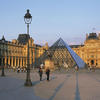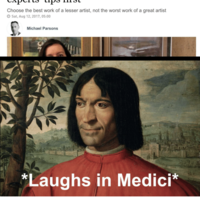More about The Presentation of the Portrait of Marie de' Medici to Henri IV

Contributor
Before selfies and Snapchat, royal portraits traveled miles to reach potential suitors and this image depicts Henry IV taking a peek at his future wife, Marie de’ Medici.
This painting portrays their marriage as one that was destined for happiness but that was far from the truth. Henri IV’s mistresses were not necessarily a secret in the French court and he had even promised to marry one before he married Marie. This made Marie’s life in the French court pretty awkward and dramatic. The image of a blissful marriage blessed by the gods was in fact propaganda commissioned later in history by Marie when she held considerably more power in the French court.
The marriage between Marie and Henry IV was advantageous for France in a few ways. The 50-year-old heirless king needed a child for the throne and Marie was the ripe age of 27 at the time. Marie’s Catholic ties would appease the Catholic nation of France, which wasn’t totally pleased with their previously Protestant King. Debt, of course, would be the third reason and the reason Henry IV was cool with the marriage despite having promised his lover otherwise. The French owed the Medicis quite a lot for backing their military ventures and Marie came with a hefty dowry. Marie’s marriage wasn’t the happiest, but it only lasted about ten years. Henry was assassinated by a Catholic fanatic in Paris and since their son Charles XIII was too young, Marie became Queen Regent.
Marie de’ Medici ran the country like a boss for seven years. She was a major patron of the arts; one of her most successful ventures was the Luxembourg Palace and garden that expanded the urban landscape of Paris to the left bank of the Seine. Before she built the Luxembourg Palace, the city had not quite expanded to the left bank that holds Montparnasse and the Latin quarter today. Although many thought the royal throne suited Marie well, some were not pleased, including her son Charles XIII. Tired of watching his mother rule on his behalf and influenced by other courtiers, Charles XIII pulled a Tommen Baratheon and exiled his mother in 1617.
Marie posed a threat even during exile when she supported a group planning to overthrow her son. Considering her position outside the capital was now a threat, she was allowed to return to the capital in 1620 under some conditions. Of course immediately upon her return she commissioned the Marie de’ Medici series to glorify and commemorate her time as Queen Regent of France. This unprecedented series included twenty four life-size portraits dedicated to a female ruler.
This brings us back to the painting in question. This particular painting depicts the presentation of Marie’s portrait to Henry IV with all of its fallacies and heavy-handed symbolism. Rubens was not subtle here. The idea of marriage is reiterated with Hymen, the god of marriage holding the portrait and Jupiter and Juno watching the presentation from the heavens. Cupid, also holding the portrait, alludes to the false idea that Henry IV was in love upon seeing her portrait, while he was probably still in love with his mistress. The personification of France in blue shows the French approval of the marriage. And finally, the least helpful cherubs to ever be painted are playing with Henry’s battle gear to represent Henry’s pivot away from battle to commit to marriage. This painting, along with the twenty-three others, was created as propaganda to remind Charles XIII as well as the French court of Marie’s power.
She clearly was not ready to give up her position, which is why she was exiled again in 1631, this time permanently.
Sources
- Camara, Esperança. “Rubens, The Presentation of the Portrait of Marie de' Medici.” Khan Academy. Accessed: February 24, 2018. https://www.khanacademy.org/humanities/ap-art-history/early-europe-and-…
- Galletti, Sara. "Female Agency and Early Modern Urbanism: The Paris of Maria De’ Medici." Journal of the Society of Architectural Historians 71, no. 2 (2012): 186-203. doi:10.1525/jsah.2012.71.2.186.
- Johnson, Geraldine A. “PICTURES FIT FOR A QUEEN: PETER PAUL RUBENS AND THE MARIE DE' MEDICI CYCLE GERALDINE A. JOHNSON.” Art History 16, no. 3 (1993): 447–69. doi:10.1111/J.1467-8365.1993.TB00536.X
- Tolley, Thomas. "States of Independence: Women Regents as Patrons of the Visual Arts in Renaissance France." Renaissance Studies 10, no. 2 (1996): 237-58. http://www.jstor.org/stable/24412270.












